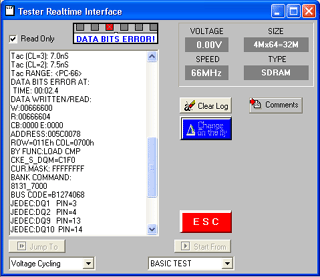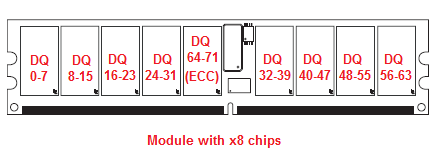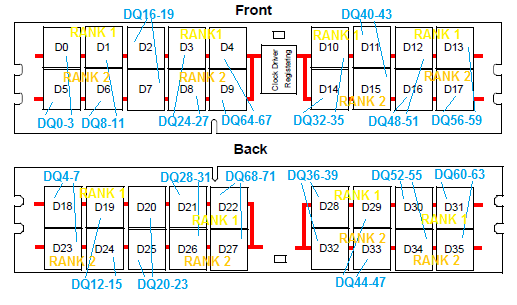Is There A Software Repair For Memory Ram
Fast, reliable techniques to repair retentiveness modules with the RAMCHECK® LX retentiveness tester
The RAMCHECK Threescore retention tester is a powerful tool for repairing lacking DIMM and SODIMM modules by pinpointing the defect and identifying the defective flake. Of course, the first thing y'all need to do is examination the suspect module to ostend that it is faulty. This takes just a few seconds with RAMCHECK Threescore.
RAMCHECK LX will apace identify the module'south speed, size and type, and give a pass/fail message. RAMCHECK Sixty fault letters likewise generally identify the relevant pins (circuit connections to the examination socket) of the module being tested which are associated with the problem. It is designed to provide y'all with explicit mistake data to enable y'all to identify the lacking component(southward) on the module.
 | RAMCHECK LX reports information $.25 error in each rank explicitly, using two lines. The first line is the "byte" view, indicating errors within byte 1 to byte 8 for an x64 module. Y'all can coil left or right, as the second line shows the private bad bits within the bytes highlighted in the first line. In this example, DQ31 of RANK 2 is bad. |
| Utilize F3/F4 to get more than detailed error information | |
 | The first printing of button F4 replaces the module size speed info in the bottom line with the explicit DQ fault (DQ31 in this example). It as well indicates the module pin number which is connected to this DQ line. Equally you will see below, knowing the DQxx error tells you which flake is bad! |
 | Pressing F3 returns to the previous screen, an additional press of F4 drills down into more information. Here it tells you the address where the error was detected. |
 | Press F4 again to meet the Row/Column component of the address at which the fault was detected. |
 | Printing F4 once again to run across the hexadecimal error in a 64 bit double word. |
 | You lot tin besides come across which test type found the electric current fault. In this instance, the error was constitute by an assortment blazon examination that scans the retentivity array. |
 | Hither it shows the data in the Southward control lines. The S control lines include four lines, S[iii],S[two], South[1] and Due south[0], each decision-making ane of the module's ranks. A module may accept one to four ranks, marked RANK1, RANK2, RANK3, and RANK4. Ranks are strictly used in social club, so that a 2-rank module must apply RANK 1 and RANK2 (never RANK3 or RANK4). In this instance, Due south=2 means that S[3]=0, Due south[2]=0 South[one]=one and S[0]=0, indicating RANK2. The B2/0 indicates RANK2 with bank address BA=000. In another example of a 4-rank module, a bulletin similar "S=4 B3/5" is interpreted equally follows: "S=4" means S[3]=0, S[two]=i S[1]=0 and S[0]=0, indicating RANK3. "B3/v" indicates RANK3 with bank address BA=101. |
When RAMCHECK Sixty reports a data scrap mistake, it tells you which DQ bit/s are bad and it also identifies the relevant pins (circuit connections to the test socket) of the module which are associated with the bad $.25. Yous can remove the module from the socket and review the Test Log of the last retention test by pressing F4 during Standby. Easier notwithstanding, use the RAMCHECK PC interface to identify faults (meet below).

Spotting the Defective Memory Chip
Every retentiveness module has fries that are arranged from left to right (when you lot look at rank 1) in accord with the bits (each bit has a DQ number) of the module. RAMCHECK LX information errors conspicuously identify the DQ scrap/s which are bad and it tells you which chips are being used. You can easily identify the bad chip from the RAMCHECK LX information errors every bit follows.
The most popular modules (regardless of size and DDR1/2/3 type) use individual chips with x8 data width. Therefore, x64 module uses 8 such chips per rank and ECC (x72) uses 9 fries. The get-go chip on the left e'er connects to DQ0-7. The second bit connects to DQ8-15, the third scrap from the left connects to DQ16-23, then forth. The ECC bit (for DQ64-71), if bachelor, is placed in the centre of the module as the 5th chip, as shown in the following drawing.

For case, if RAMCHECK Threescore reports the error DQ17 bad, yous know it is the third chip (DQ16-23) from the left. If y'all test a dual rank module (one that has chips in both sides), you need to follow the RANK number reported by RAMCHECK LX. If it is RANK 2, yous need to turn the module over and follow the chips in a reversed club - DQ0-vii of RANK 2 will be the first chip on the right side when you look at the dorsum side of the module.
Similarly, an x64 data width module (regardless of size) that uses x16 information width individual chips, has 4 chips per rank. The first chip on the left always connects to DQ0-15. The 2d scrap connects to DQ16-31, the third chip from the left connects to DQ32-47, and and then forth, as shown in the following drawing. And so if for example RAMCHECK LX reports the error DQ30 bad in RANK ane, you know it is the 2d chip.

If RAMCHECK reports DQ30 in RANK 2, the bad chip will exist the 2d from the right when yous wait at the back side of the module, as shown here
Server ECC x72 modules with x4 chips also have a regular orderly arrangement and your technician tin convert the RAMCHECK LX fault report to identify the chips. Such module are typically include 36 chips, for ii RANKS. The following drawing illustrates how the fries are connected. The chips marked D0-D4, D10-D13, D18-D22 and D28 to D31 comprise RANK ane. The chips marked D5-D9, D14-D17, D23-D27 and D32-D35 comprise RANK 2 of the module. The vertical chips pairs (e.g D0 and D5, D1 and D6, etc.) connect in parallel, and command by module control lines S0 (for RANK 1) or S1 (for RANK 2). Fries D0 and D5 connects to DQ0-3 in the front of the module. Chips D18 and D23, which are placed directly beneath D0 and D5 on the back of the module, connect to DQ4-seven. Continuing in this gild, chips D1 and D6 connect to DQ8-11 on the forepart side of the module. Fries D19 and D24 on the back of the module connect to DQ12-15, and so on. Finally, the concluding chip pair in the forepart side (D13 and D17) connect to DQ56-59 while the chips D31 and D35 beneath them on the back side of the module connect to DQ60-63. Server ECC x72 modules with x4 fries and only 1 rank are much less popular. The arrangement of the chips is like to the to a higher place drawing, with the omission of chips D5-D9, D14-D17, D23-D27 and D32-35. More than explicit drawings of modules is bachelor in the JEDEC spider web site, merely the above drawing should exist sufficient to determine the chips in most cases. Now that yous know where the defective chip is you'll take to supersede it. Only a technician with component-level repair expertise tin can repair a memory module. The required soldering/ desoldering equipment is relatively complex, especially with modules and cards made with extremely thin Surface Mount Technology (i.e., devices with BGA or TSOP chips). You will need a skillful bargain of practice with desoldering techniques. Nevertheless, a few pocket-sized bug, which are identified by RAMCHECK, tin be repaired with simple tools. A brusk betwixt an adjacent pin may exist caused by a small piece of metal droppings, which is stuck between two fries. You "repair" the module in this example with an Exacto knife or a watchmaker's fine screwdriver past simply removing the debris. If you use RAMCHECK in the product shop, you should be able to hands supercede the module's components. Repairing memory does involve a fair amount of piece of work, but every bit companies around the world have discovered with RAMCHECK LX, it can be a lucrative business. Structure analysis for RAMCHECK test results - important for retention module repair. Our squad volition contact you equally presently as possible. 

Related Resources:
Please ship me more than info
Source: https://www.memorytesters.com/articles/memory_repair.htm
Posted by: carternointian1976.blogspot.com


0 Response to "Is There A Software Repair For Memory Ram"
Post a Comment